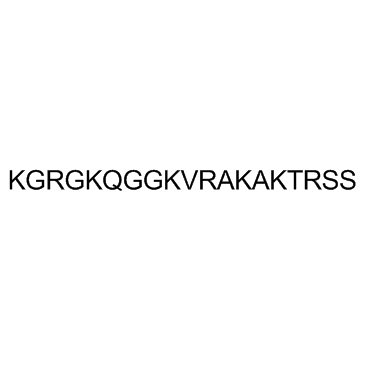219552-69-9
| Name | Parasin I |
|---|---|
| Synonyms |
MFCD02261960
L-Lysylglycyl-L-arginylglycyl-L-lysyl-L-glutaminylglycylglycyl-L-lysyl-L-valyl-L-arginyl-L-alanyl-L-lysyl-L-alanyl-L-lysyl-L-threonyl-L-arginyl-L-seryl-L-serine L-Serine, L-lysylglycyl-L-arginylglycyl-L-lysyl-L-glutaminylglycylglycyl-L-lysyl-L-valyl-L-arginyl-L-alanyl-L-lysyl-L-alanyl-L-lysyl-L-threonyl-L-arginyl-L-seryl- |
| Description | Parasin I is a 19-amino acid histone H2A-derived peptide isolated from the skin of the catfish, and shows antimicrobial activity. |
|---|---|
| Related Catalog | |
| In Vitro | Parasin I with comparable antimicrobial activities localized to the cell membrane and subsequently permeabilized the outer and cytoplasmic membranes. Parasin I and its active analogs show strong cytoplasmic membrane permeabilizing activity[1]. Codon optimized parasin I fused with human lysozyme is expressed in Pichia pastoris, and has potent antibiotic activity[2]. |
| Cell Assay | The antimicrobial activity of each peptide is determined using the broth microdilution assay. Briefly, single colonies of bacteria and fungi are inoculated into 3% trypticase soy broth (TSB) and Saboraud's medium, respectively, and cultured overnight at 37 and 30°C, respectively. Aliquots of each culture are transferred to 50 mL of fresh medium and incubated for an additional 3-6 h to obtain midlogarithmic phase cells. The cells are then washed and resuspended in 10 mM sodium phosphate buffer (NAPB), pH 7.4. The relationship between absorbance at 620 nm and colony-forming units (cfus) is determined for each microorganism by spreading serial dilutions of the cell suspension onto TSB or Saboraud agar plates. The cell suspension is diluted to 5×105 cfu/mL with 10 mM NAPB. Each well of 96- well propylene microtiter plates is filled with 90 mL of the diluted suspension and 10 mL of serially diluted peptide samples. After incubation for 3 h, fresh medium is added to the mixture and incubated at 37°C (bacteria) or 30°C (fungi) for an additional 16 h. The inhibition of growth is determined by measuring absorbance at 620 nm with a Model 550 Microplate Reader. The lowest concentration of peptide that completely inhibits growth is defined as the ‘minimal inhibitory concentration’ (MIC). The MICs are the average values obtained in triplicates in three independent experiments. |
| References |
| Density | 1.5±0.1 g/cm3 |
|---|---|
| Molecular Formula | C82H154N34O24 |
| Molecular Weight | 2000.314 |
| Exact Mass | 1999.187500 |
| LogP | -13.48 |
| Index of Refraction | 1.658 |
| Storage condition | 2-8℃ |
